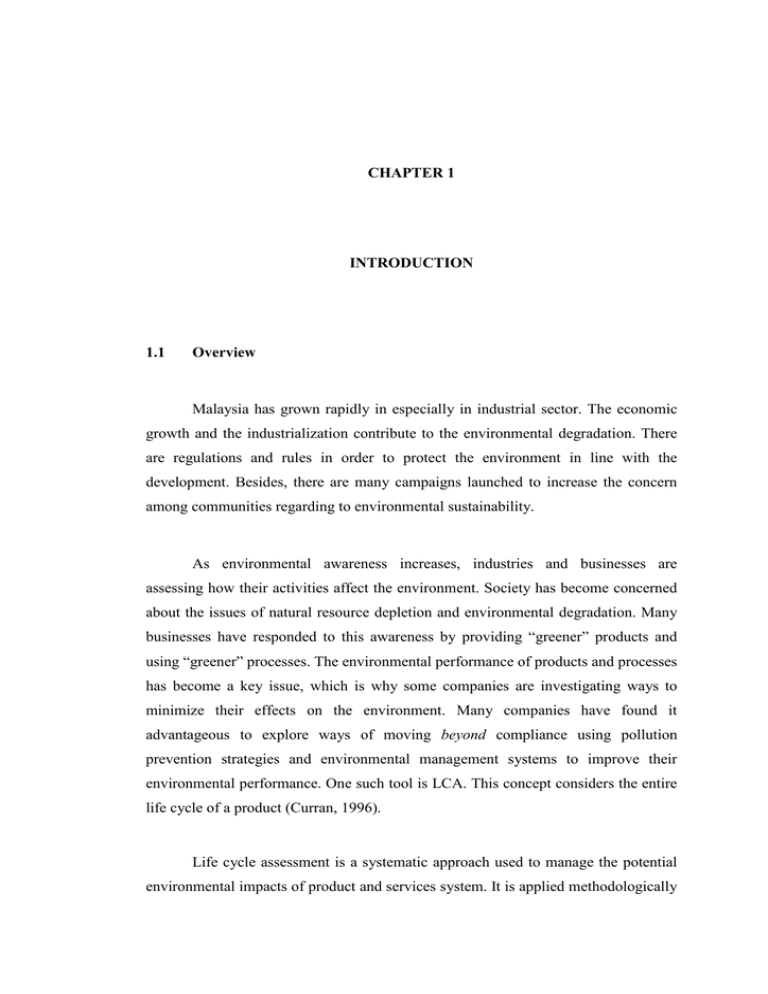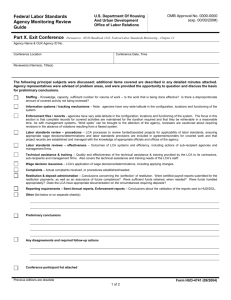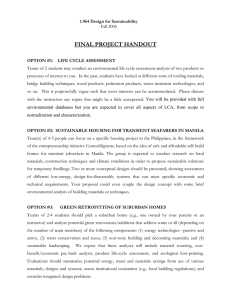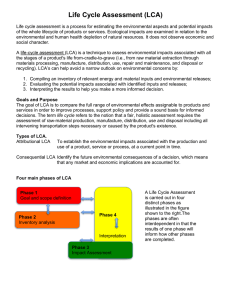CHAPTER 1 INTRODUCTION 1.1 Overview
advertisement

CHAPTER 1 INTRODUCTION 1.1 Overview Malaysia has grown rapidly in especially in industrial sector. The economic growth and the industrialization contribute to the environmental degradation. There are regulations and rules in order to protect the environment in line with the development. Besides, there are many campaigns launched to increase the concern among communities regarding to environmental sustainability. As environmental awareness increases, industries and businesses are assessing how their activities affect the environment. Society has become concerned about the issues of natural resource depletion and environmental degradation. Many businesses have responded to this awareness by providing “greener” products and using “greener” processes. The environmental performance of products and processes has become a key issue, which is why some companies are investigating ways to minimize their effects on the environment. Many companies have found it advantageous to explore ways of moving beyond compliance using pollution prevention strategies and environmental management systems to improve their environmental performance. One such tool is LCA. This concept considers the entire life cycle of a product (Curran, 1996). Life cycle assessment is a systematic approach used to manage the potential environmental impacts of product and services system. It is applied methodologically 2 to build a quantitative inventory of environmental burdens or releases, evaluate their potential impacts and consider the alternatives to interpret the results or improve environmental performance. LCA can be used to identify critical life cycle stages or burdens for which additional environmental assessment tools (such as risk assessment) may be applied to fully understand the potential impacts and risks. In any application, LCA considers the potential environmental impacts along the continuum of a product’s life (i.e., cradle to grave or cradle to cradle), from raw materials acquisition to production, use, and disposal or recovery. The potential environmental impacts to consider include resource depletion human health, and ecological health (Fava, 2005). Most conventional approaches in environment protection only focused on single medium such as air, water or soil, a single stage in the product life cycle like during the production, use or disposal of the product or in single issue for instance chemical limit to an individual. These strategies not always reduce the whole environmental impact. Pollution control resources are spent on activities required by laws and regulations, however do not always provide the most efficient use of those resources in terms of reducing impacts. Sometimes it allows another unexpected impact to occur because it is not designed to tackle the overall environmental problem. The result of an LCA study helps identify the opportunities and risk of a product or technology from the extraction of raw material to the final disposal. LCA helps how our choices influence each of these stages, so positive on economy, environment and society can be made. As industrialization in Malaysia growth rapidly, pollutions can not be avoided. Even there are legislation and regulation to protect the environment, it still not enough to put Malaysia away from environmental problem especially handling industrial waste. Besides depend on the legislation and regulation, Malaysia should adopt a new way to sustain the environment. LCA can assist in identifying opportunities to improve the environmental aspects of products at various points in 3 their life cycle, decision making in industry, government or non government and marketing as well. 1.2 Problem Statement In 2000, the major contributors to water pollution were effluents from manufacturing industries with an estimate of 43% and urban domestic sewage facilities, which amounted to 46.1% of the total water pollutants in the country. The pollution loads contributed by these pollutants significantly affected the river quality. An analysis of manufacturing industries in 2000 showed that the food and beverage industry constituted 23.7% of the total sources of water pollution, while electrical and electronic industries accounted for 11.4%. The chemical industry was found to contribute 11.2% and the paper industry generated 8.8% of the total pollution. The textile and finishing/electroplating industry accounted for 7.4 and 5.3% water pollution sources, respectively (Suleyman et al, 2005). Since economic development tends to cause an increase in the amount of industrial waste generation, environmentally-sound management of industrial waste is essential to promote the LCA. Life Cycle Assessment (LCA) is an internationally recognised methodology for assessing the environmental impacts and a systematic approach to manage the potential impacts of products and services. Environmental impact of the whole aspect of the system or product can be assessed by implementing LCA. Before the implementation can be applied, one must have the knowledge and awareness of the LCA. 4 1.3 Scope of the Study Figure 1.1: Location of study area This study looks only into the awareness of LCA among the manufacturers of light industry in Taman Universiti, Skudai,Johor and willingness to perform LCA in their company. Taman Universiti Industrial Park is a light industrial area in Skudai. This area consists of various industries such as paper, plastic, metal and food. The respondents of the study are selected randomly among the manufacturers in Taman University, Skudai, Johor. 1.4 Objectives of Study This study aims to evaluate the awareness of LCA in industrial sector and their point of view of LCA. Thus the objectives of the study are to: i. Evaluate the awareness of LCA. ii. Evaluate the willingness to perform LCA in their company. 5 1.5 Significant of the Study This study is focusing on awareness of LCA among the manufacturers in light industry at Taman University. Implementing of LCA give more benefit not only to the manufacturers but also to the customers and the environment. By knowing the level of awareness of LCA, a progressive step can be taken in order to introduce or improve their knowledge on LCA. Even though they are only a small industrial sector, they also contribute to environmental degradation. LCA can give them better choice in making decision by taking the environmental aspect in their consideration.



